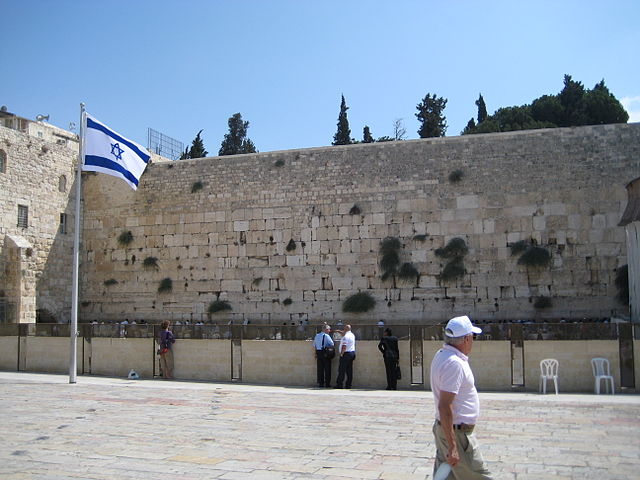The Kotel or Western Wall or Wailing Wall is the last remaining part of the Temple that was destroyed by the Romans in the year 70. The Kotelis actually one of the outer retaining walls of Temple Mount; but, today it is considered the holiest site in the world that is readily accessible to Jews. (Temple Mount itself is holier; but is largely inaccessible to Jews due to a combination of international politics and the lack of ritual purity.)
When a Jew thinks of spiritual Jerusalem; then this is the image in the mind’s eye. The Kotel never closes – it is always open to receive a prayer; no matter from which religion. On festivals and Sabbaths there is often a teeming mass, with dancing and impassioned prayers. Visitors of all denominations have said that they can feel something special at the Kotel and for many a visit to the Kotel is one of the highlights of their trip.
It is okay to photograph except on holy days (just follow the signs) but as a religious site you are advised to dress modestly. The upper plaza of the Wailing Wall is more social in nature where you can observe from a distance and meet up with family; whilst the lower plaza of the Western Wall is the prayer area and it is strictly men to the left – women to the right.
There is actually a lot more to the Kotel than meets the eye. Firstly, the Western Wall extends to the right and left under the arches. The Wailing Wall also extends a good way to the left through the Muslim Quarter and it can be seen in various places. Of course, over time the level of the city has risen with debris of previous generations being buried – so the Wailing Wall also goes a long way down.
The Western Wall also extends to the right (south) of the main plaza beyond the ramp to Temple Mount and meets the Southern Wall. This area is located in the Davidson Center.
Finally, a path has been excavated along the outside of the Western Wall – the Kotel Tunnels. This is a unique experience of history and spirituality, but it is extremely popular and you should book in advance to ensure that you get to visit (you are advised to do this immediately after you book your flight).

When to Visit the Kotel
The Kotel is always open for prayers and meditation and you will always find people at the Western Wall. Shabbat, Monday & Thursday mornings together with the Jewish Festival days are considered to have the “most action.” There are many who prefer slightly less bustle. I personally like the evening – the plaza is much cooler, there is a new atmosphere and the relative quietness make this a special time. (See the Kotel by Night Album)
If you happen to be in Jerusalem during Pesach and Sukkot then there is a mass priestly blessing – many priests make a special effort to attend and there is (unusually) a single service. Many come to receive the blessing and the whole area is packed with people and spirituality. It normally takes place on the third day of the festival but please verify the exact day and the time if you plan to attend (allow plenty of time for the crowds).
Getting to the Kotel – Western Wall – Wailing Wall
The Wailing Wall (Kotel) and plaza are wheelchair accessible, but you must arrive at the vehicular entrance near Dung Gate (enter via Dung Gate or via Jaffa Gate and then along the inner perimeter road). The two entrances from the Old City involve a considerable number of steep steps. Vehicular access is heavily restricted in the Old City and parking is a nightmare so the best advice is to arrive and leave by taxi.
Pedestrians may arrive via the Jewish Quarter, The Muslim Quarter (from the souk) or via public transport bus 1, 2, 3, 38a
